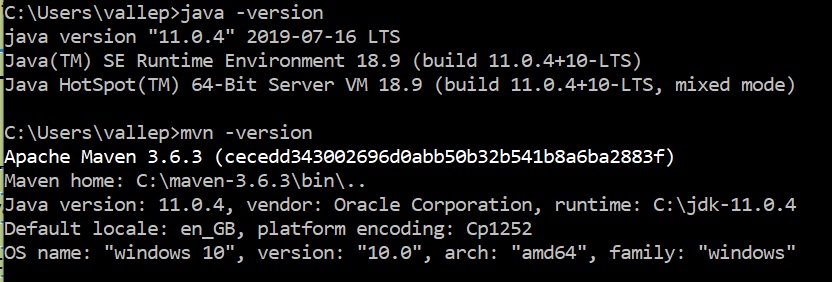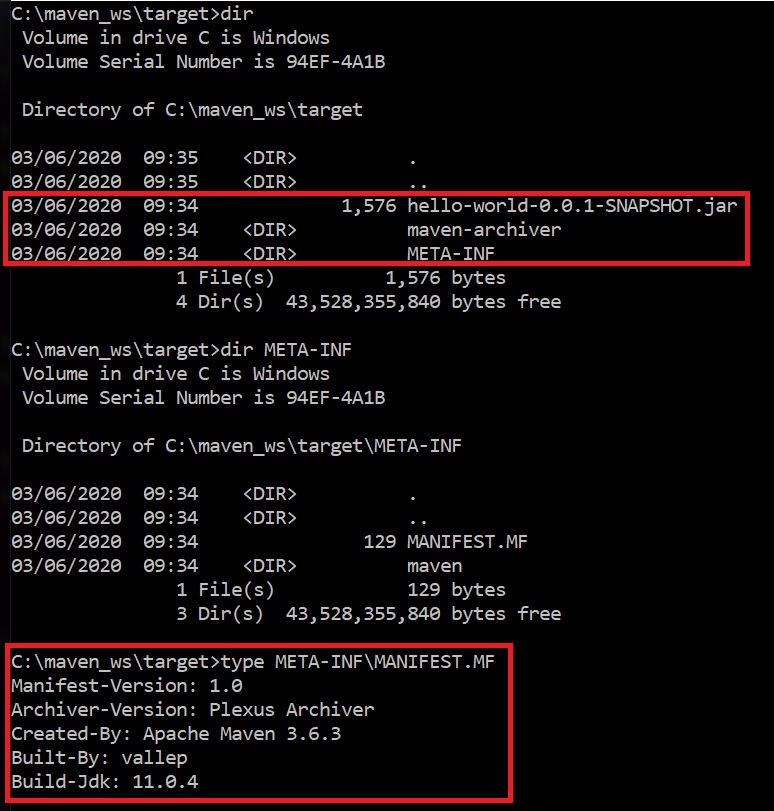Apache Maven is sotware project management tool, it uses the Project Object Model (POM) to manage builds (lifecycle), dependencies, reporting and documentation of software projects. It is primarily used for Java projects but can be used for many other programming langages as well. A XML file (POM file) is used to describe the software project on how it should be built, the build order, what dependencies are required, how to retrieve other software that is required, what plugins are required and to be used (there are many plugins available), etc. Maven supports all major IDE's and is used by many large Open Source Projects like Spring Framework, Spring Boot.
As of writing this Apache Maven is at version 3.6.3 in June 2020, and the Apache Maven website will have the latest downloads and documentation.
Maven has also established some standards which help developers coexist and be able to work on the same projects with out too much disruption
- Maven Standard Directory Layout - this has been adopted by many other build tools
- Artifact Naming - this is how Java artifacts are named
- Artifact Repositories - a standard for the structure of artifact repositories
I am not going to explain how to install Maven as there is already many web pages on the internet how how to do this, and of course you have the Apache Maven website as well. Once you have installed Maven and Java you should be able to check both from the commandline, notice that the command for maven is mvn

| Maven version | mvn -version |
| Maven help | mvn -help |
In Java you create a Java source file (.java) and then compile it into a class file (.class) this is byte code that the Java Virtual Machine (JVM) understands and is able to execute. You then can package up a number of .class files into a Java Archive called a jar file (.jar) this generally is a complete application, there are also other Java packaging that can be used.
Remember that once we get into Maven all this will be done for us under the covers, this is so that you understand what Maven will be doing for us.
- *.jar - zip file containing one for more class files
- *.war - zip file containing web application which includes one or more jar files, class files and web resources, used with Tomcat/JBoss, WebSphere
- *.ear - zip file containing one or more WAR files (see above), used with Tomcat/JBoss, WebSphere
- Fat JAR (Uber JAR) - executable JAR file containing all dependencies (Spring Boot), used as standalone as they contain a embedded application server like tomcat.
- Docker Container - docker image containing a JVM and Java application (package), standlone and used by a docker server.
There are a common set of tools that you can use when developing in Java from running, compiling, packaging (Jar file), documentation, etc I provide a table below of the most commonly used:
| Running | java [--class-path, --classpath, -cp] java [-verbose:class] java [-verbose:gc] java Test # Run a java program without a package configured java Test arg1 arg2 arg3 # Run a java program without a package configured and pass 3 arguments java uk.co.datadisk.Test # Run a java program with a package of uk.co.datadisk, remember you are running from the root directory uk/co/datadisk, dont from from inside uk/co/datadisk the same directory as the class java uk.co.datadisk.Test arg1 arg2 arg3 # Run a java program with a package and pass 3 arguments java -classpath myjar.jar HelloWorld # execute and run a jar file |
| Compiling | javac -d # set the destination output directory of the class file javac -gc # generates all debugging info javac -g:[lines, vars, source] # generates specific debugging info javac -verbose # outputs compiler info javac HelloWorld.java # creates a .class file (byte code file) |
| Packaging | jar [-c, --create] # create a JAR archive file jar -C # changes the specified directory and includes the files at the end of the commandline jar [-f, --file] # specifies the name of the JAR file jar [-m, --manifest] # includes the manifest file information jar cf myjar.jar Helloworld.class # this will create a jar file |
| Other useful tools | javap -c # prints disassembled code javadoc # generate API documentation in HTML format jlink # assemble and optimize a set of modules and their dependencies into a custom runtime image jmod # create JMOD files and list the content of an existing JMOD file jdeps # Java class dependency analyzer jdeprscan # static analysis tool that scans a jar file |
Getting Started with Maven (commandline)
This section we take a very simple look at Maven in other sections I will cover more advanced features.
| Very Basic POM XML file |
<?xml version="1.0" encoding="UTF-8"?>
<project xmlns="http://maven.apache.org/POM/4.0.0"
xmlns:xsi="http://www.w3.org/2001/XMLSchema-instance"
xsi:schemaLocation="http://maven.apache.org/POM/4.0.0 http://maven.apache.org/xsd/maven-4.0.0.xsd">
<modelVersion>4.0.0</modelVersion>
<groupId>uk.co.datadisk</groupId>
<artifactId>hello-world</artifactId>
<version>0.0.1-SNAPSHOT</version>
<properties>
<project.build.sourceEncoding>UTF-8</project.build.sourceEncoding>
<project.reporting.outputEncoding>UTF-8</project.reporting.outputEncoding>
<java.version>11</java.version>
<maven.compiler.source>${java.version}</maven.compiler.source>
<maven.compiler.target>${java.version}</maven.compiler.target>
</properties>
</project> |
| POM Breakdown | |
| xml | ## This defines the XML version and any encoding, the XML declaration describes some of the most general properties of |
| project, schema and namespacing | ## This is the top level element and defines the schema used and any namespaces, also defines all the rules and elements that can be used.
<project xmlns="http://maven.apache.org/POM/4.0.0"
xmlns:xsi="http://www.w3.org/2001/XMLSchema-instance"
xsi:schemaLocation="http://maven.apache.org/POM/4.0.0 http://maven.apache.org/xsd/maven-4.0.0.xsd"> |
| model version | ## This element indicates what version of the object model this POM is using. <modelVersion>4.0.0</modelVersion> |
| group ID | ## indicates the unique identifier of the organization or group that created the project. The groupId is one of the key |
| artifact ID | ## This element indicates the unique base name of the primary artifact being generated by this project. The primary artifact |
| version | ## This element indicates the version of the artifact generated by the project. Maven goes a long way to help you with version |
| properties | ## Maven properties are value placeholder, their values are accessible anywhere within a POM by using the notation ${X}, |
Once we have a POM file we can run a number of Maven commands from the commandline, if you use the package command a target directory will be created, a JAR file will be created that contains a Manifest file and Maven pom.xml, pom.properites file. Some of the maven (mvn) commands you need a pom.xml file otherwise it will complain.
If you have a java file in src/main/java this would then get compiled and the class file will end up in target/classes directory.

| Maven clean | mvn clean |
| Maven package | mvn package |
You can add dependencies in the pom.xml file, this will reach out to the maven repository and download the neccessary JAR file.
| dependencies | ## Any dependencies required will be automatically downloaded from the Maven Repository
<dependencies>
<dependency>
<groupId>org.apache.commons</groupId>
<artifactId>commons-lang3</artifactId>
<version>3.8.1</version>
<dependency>
</dependencies> |